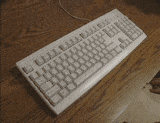Pressing Ctrl+Alt+Delete
How to do it
The Ctrl+Alt+Delete key combination applies to desktop or laptop computers running Microsoft Windows.
Sometimes people have trouble executing this keyboard combination, because they think there is some special timing or skill involved. This is not so. It's really easy. Just think of Ctrl and Alt as Shift keys, and use them the way you use Shift to type a capital letter. You can execute Ctrl+Alt+Delete in two easy steps:

- Press and hold Ctrl and Alt at the same time. You don't have to strike them both at the same time; just get them both down and hold them.
- When you're ready, tap and release the Delete key. You will see the results immediately, and you can now let go of Ctrl and Alt.
Ctrl may be labeled Control on your keyboard, and Delete may be labeled Del on your keyboard.
What it is for
This special key combination, pronounced "Control Alt Delete," has been around since the Personal Computer was introduced by IBM in 1981. The PC recognized this as a command to clear all software and data from its memory and reload its software from disk (called rebooting). This was useful when the computer had frozen up due to a program crash. It involved three keys so you would not strike it by accident—the PC would always restart immediately no matter what programs you had open!
On current Microsoft Windows based computers, Ctrl+Alt+Delete doesn't do this anymore, but it does still send a unique signal from your keyboard that is specially handled by your computer hardware and the Windows operating system software. Some examples of its application:
- If your computer is part of a business network, you have to do it before you can type your user name and password to sign in to Windows. This prevents any running software (including malware) from intercepting your password as you type it.
- Once you are signed in, Ctrl+Alt+Delete brings up a special system control menu called Windows Security, from which you can lock your computer, change your password, sign out, shut down the computer, and open the Task Manager to shut down individual programs. This is designed to work, just as on the oldest computers, even if a program has frozen up your computer. But, in rare cases where your computer is very badly jammed, you might get no response in Windows when you press Ctrl+Alt+Delete; since it's more complicated for the Windows operating software to bring up a menu than it was for pre-Windows PCs to simply perform a hardware reset.
- When a computer has been locked—meaning you keep your programs running but everything is hidden—you have to use Ctrl+Alt+Delete, then type your password, to unlock it.
- When you back up your saved passwords, Windows will ask you to press Ctrl+Alt+Delete before it will copy them to a disk or thumb drive.